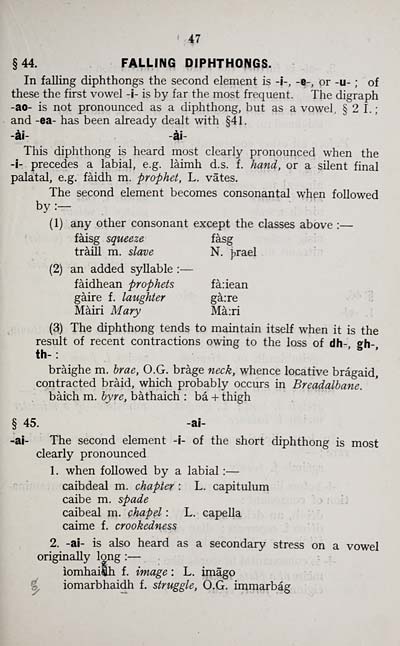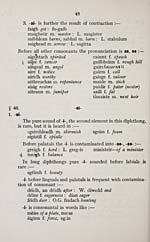Matheson Collection > Gaelic grammar, containing the parts of speech and the general principles of phonology and etymology, with a chapter on proper and place names
(67)
Download files
Complete book:
Individual page:
Thumbnail gallery: Grid view | List view

47
§44. FALLING DIPHTHONGS.
In falling diphthongs the second element is -i-, -e-, or -u- ; of
these the first vowel -i- is by far the most frequent. The digraph
-ao- is not pronounced as a diphthong, but as a vowel, § 2 I. ;
and -ea- has been already dealt with §41.
-ài- -ài-
This diphthong is heard most clearly pronounced when the
-i- precedes a labial, e.g. làimh d.s. f. hand, or a silent final
palatal, e.g. fàidh m. prophet, L. vates.
The second element becomes consonantal when followed
by:-
(1) any other consonant except the classes above : —
fàisg squeeze fàsg
tràill m. slave N. j^rael
(2) an added syllable : —
fàidhean prophets fà:iean
gàire f. laughter gà:re
Màiri Mary Mà:ri
(3) The diphthong tends to maintain itself when it is the
result of recent contractions owing to the loss of dh- gh-
th- : ' ^ '
bràighe m. hrae, O.G. bràge neck, whence locative bràgaid,
contracted braid, which probably occurs in Breadalbane.
bàich m. byre, bàthaich : bà + thigh
§ 45. -al-
-al- The second element -i- of the short diphthong is most
clearly pronounced
1. when followed by a labial : —
caibdeal m. chapter : L. capitulum
caibe m. spade
caibeal m. chapel : L. capeUa
caime f. crookedness
2. -al- is also heard as a secondary stress on a vowel
originally long : —
iomhailh f . image : L. imago
g, iomarbhaidh f. struggle, O.G. immarbag
§44. FALLING DIPHTHONGS.
In falling diphthongs the second element is -i-, -e-, or -u- ; of
these the first vowel -i- is by far the most frequent. The digraph
-ao- is not pronounced as a diphthong, but as a vowel, § 2 I. ;
and -ea- has been already dealt with §41.
-ài- -ài-
This diphthong is heard most clearly pronounced when the
-i- precedes a labial, e.g. làimh d.s. f. hand, or a silent final
palatal, e.g. fàidh m. prophet, L. vates.
The second element becomes consonantal when followed
by:-
(1) any other consonant except the classes above : —
fàisg squeeze fàsg
tràill m. slave N. j^rael
(2) an added syllable : —
fàidhean prophets fà:iean
gàire f. laughter gà:re
Màiri Mary Mà:ri
(3) The diphthong tends to maintain itself when it is the
result of recent contractions owing to the loss of dh- gh-
th- : ' ^ '
bràighe m. hrae, O.G. bràge neck, whence locative bràgaid,
contracted braid, which probably occurs in Breadalbane.
bàich m. byre, bàthaich : bà + thigh
§ 45. -al-
-al- The second element -i- of the short diphthong is most
clearly pronounced
1. when followed by a labial : —
caibdeal m. chapter : L. capitulum
caibe m. spade
caibeal m. chapel : L. capeUa
caime f. crookedness
2. -al- is also heard as a secondary stress on a vowel
originally long : —
iomhailh f . image : L. imago
g, iomarbhaidh f. struggle, O.G. immarbag
Set display mode to: Large image | Transcription
Images and transcriptions on this page, including medium image downloads, may be used under the Creative Commons Attribution 4.0 International Licence unless otherwise stated. ![]()
| Permanent URL | https://digital.nls.uk/76600918 |
|---|
| Description | Items from a collection of 170 volumes relating to Gaelic matters. Mainly philological works in the Celtic and some non-Celtic languages. Some books extensively annotated by Angus Matheson, the first Professor of Celtic at Glasgow University. |
|---|
| Description | Selected items from five 'Special and Named Printed Collections'. Includes books in Gaelic and other Celtic languages, works about the Gaels, their languages, literature, culture and history. |
|---|

